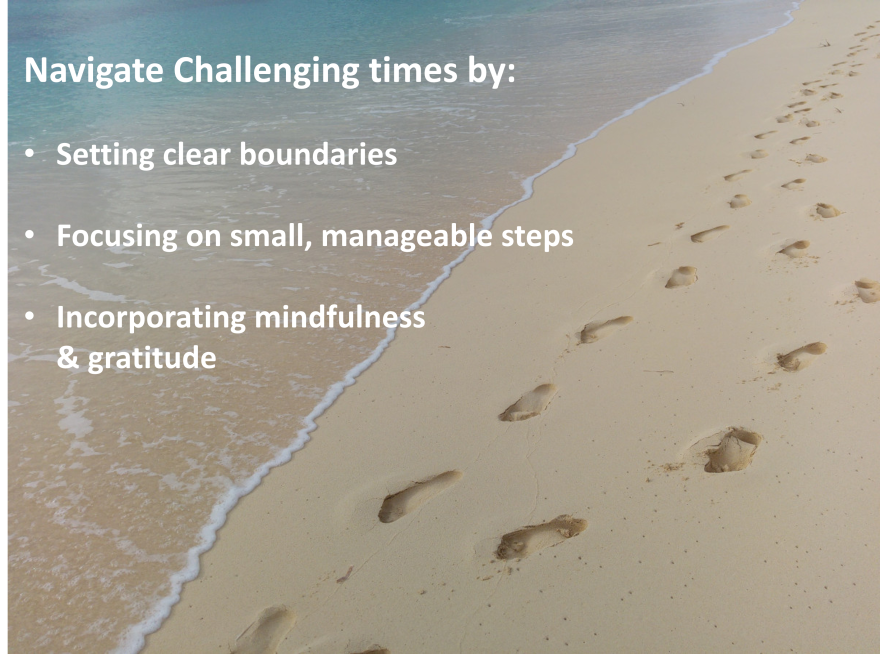|
Lately, I’ve been hearing a recurring theme in coaching sessions, conversations with friends, and even with colleagues. It seems many of us are experiencing what some describe as “overwhelming paralysis.” With all the changes and challenges surrounding us, it can be hard to know where to start, let alone keep moving forward. If you’ve been feeling this way, know you’re not alone.

In coaching, we often ask permission before we share a framework or tip, reminding our clients that they are always at choice—to accept the information, say “no way” to it, or tweak it to suit their needs. Today, I’d like to share a tip that might help you get started on navigating overwhelm. The key is to take small, intentional steps to regain control over your time and mental space.
Here’s a framework that might help you get started:
Step 1: Set Boundaries--Not Walls, But Roadmaps
When life feels chaotic, it’s tempting to retreat or put up walls. When I suggest setting boundaries, I’m not talking about building barriers that shut everything and everyone out. Instead, think about setting healthy boundaries as creating a roadmap that helps guide you toward what really matters to you and your goals.
One option is to start by creating boundaries around the information you consume. It’s so easy to get caught up in the never-ending news cycle, social media madness, or conversations that overwhelm your senses. Instead of letting all the stimulus flood your mind, decide when and how much news you’ll take in. Set specific times (and time limits) for checking updates, and choose sources that align with your needs, not just every headline.
Another important option is creating boundaries around your social interactions. It’s okay to say “no” to conversations that drain your energy. Be intentional about when and how you engage with people. Maybe you designate specific times to connect with friends or family, and other times to focus on personal reflection or rest. Remember, protecting your peace is vital to maintaining balance.
Why is all this important? Because when we allow too much external noise and negativity into our lives, it distracts us from what truly matters and can add to the overwhelm. Setting boundaries protects your ability to focus on what you want to do and preserves your peace of mind.
Step 2: Tackle Your To-Do (or "To-Day") List
When overwhelm hits, the to-do list can feel like an insurmountable mountain. The key is to shift your focus from trying to accomplish everything at once, to doing just today—one step at a time.
For example, let’s say you’re a student staring at a 10-page research paper. Instead of looking at the whole assignment and getting paralyzed by the pressure, focus on one part: maybe just writing your introduction, or gathering your sources. This breaks it down into smaller, more manageable pieces, and makes the task feel less daunting. Similarly, if you’re at work and facing a mountain of emails, you don’t need to answer every email in one go—just start with three. Checking off smaller items gives you a sense of progress.
The same approach applies to your home life. If cleaning the entire kitchen feels overwhelming, don’t think about the whole task. Focus on just one part—like wiping down the counters, or maybe organizing a single drawer. This incremental progress builds up over time, and before you know it, you’ve made significant headway.
This brings me to something I recently read on Inc.com about the “1% Rule.” While I don’t quite agree with its name, the concept really resonates with me. The essence of the rule is simple: if you improve by just 1% each day, you’ll experience significant progress over time. The core idea is that consistency and incremental growth—even in small doses—compound over time.
For instance, if you want to improve your health, you don’t need a massive overhaul all at once. Instead, commit to small habits—like drinking more water, stretching for five minutes, or adding a few extra veggies to your meals. Those small actions, done consistently, add up to long-term change.
And here’s a tip: celebrate the small wins! Notice and appreciate what you’ve already done, not just what’s left on your list. Our minds tend to focus on the things we haven’t done, but taking a moment to appreciate what’s been accomplished helps keep you motivated.
Step 3: Embrace Mindfulness and Gratitude
Finally, in times of uncertainty, mindfulness and gratitude are like anchors that keep us grounded. Being present in the moment and taking a minute to appreciate what we have—even the little things—can help shift your focus away from the chaos around you. Even on tough days, finding something to be grateful for can make a difference. It’s not about escaping what’s around us—it’s a tool that helps us navigate strong emotions and build emotional resilience.
Start small: take a few deep breaths before you begin your day, jot down three things you’re grateful for each night, or take a moment to step outside and appreciate something beautiful in nature. These small acts of mindfulness can make a big difference in helping you stay calm amid the storm.
As we navigate challenging times, it’s important to remember that setting clear boundaries, focusing on small, manageable steps, and incorporating mindfulness and gratitude into our routines can help us find peace amid the overwhelm.
If you find yourself feeling stuck, take a deep breath, and ask yourself: What’s one thing I can do right now? Don’t judge the 1 thing—whether it’s putting your phone aside, making lunch, or answering that first email—just start with one action.
We can and will move forward, one step at a time.

And remember, if you need support, don’t hesitate to reach out to your mental health provider.
With gratitude,
Ana Isabel Sánchez
   
|